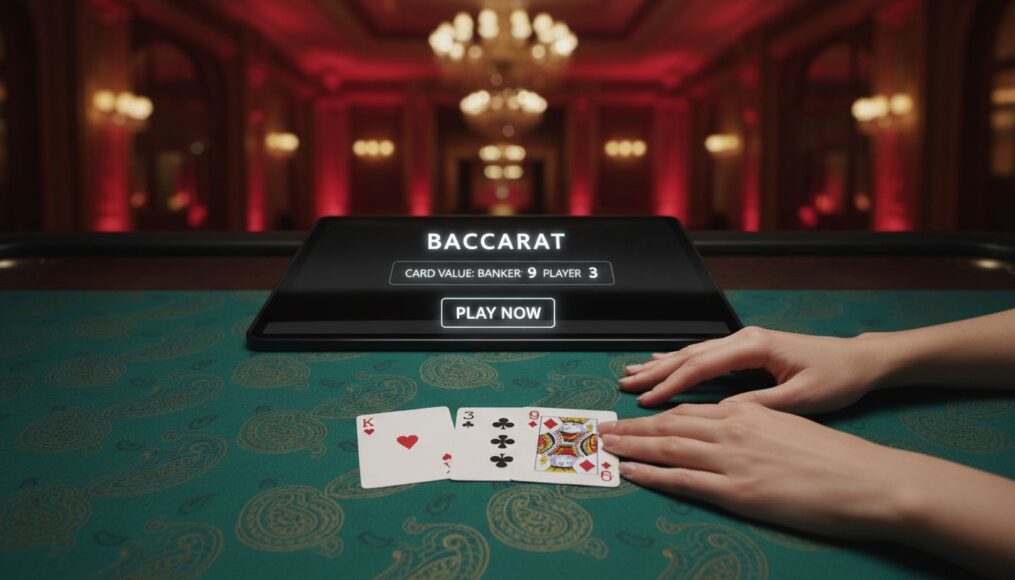The Card Value and Our Tips on How to Play Baccarat

Baccarat, a game synonymous with elegance and high stakes, has captivated players in casinos worldwide for centuries. For Indian players looking to dive into the thrilling world of online casino gaming, understanding the fundamentals of baccarat is key to an enjoyable and strategic experience. This guide will walk you through the essential rules, card values, and gameplay mechanics of baccarat, ensuring you're well-prepared to place your bets at your favourite online casino.
Often seen in Bollywood films and associated with sophistication, baccarat is surprisingly simple to learn. Unlike some other card games, you don't need to master complex strategies to play. The game's flow is largely determined by fixed rules, making it accessible even for beginners. Let's explore what makes baccarat a timeless casino classic.
What is Baccarat?
Baccarat is a popular casino game with European origins, often considered an alternative to blackjack. While both are card games, their objectives differ significantly. In blackjack, the goal is to get as close to 21 points as possible without exceeding it, playing against the dealer. In baccarat, the aim is to predict which hand – the ‘Player' or the ‘Banker' – will have a total closest to nine. You can also bet on a ‘Tie' between the two hands.
The beauty of baccarat lies in its straightforward betting options. You don't play against other players or even directly against the dealer in the same way as blackjack. Instead, you simply choose one of three outcomes: that the Player's hand will win, the Banker's hand will win, or that the two hands will result in a tie. Once bets are placed, the game unfolds according to a strict set of rules, making it a game of chance with an element of strategic betting.
Understanding Baccarat Card Values
Before you place your first bet, it's crucial to understand how cards are valued in baccarat. This system is unique and fundamental to calculating hand totals:
- Ace: Worth 1 point.
- Cards 2 through 9: Retain their face value.
- 10, Jack (J), Queen (Q), King (K): All worth 0 points.
When the total value of a hand exceeds nine, only the second digit of the sum is considered. For example:
- If a hand has a 7 and an 8, the sum is 15. In baccarat, this hand is worth 5 points (15 – 10 = 5).
- If a hand has a King (0) and a 4, the sum is 4. This hand is worth 4 points.
- If a hand has two 9s, the sum is 18. This hand is worth 8 points (18 – 10 = 8).
This unique scoring system ensures that hand totals always remain between 0 and 9, simplifying the game's objective.
How to Play Baccarat
Playing baccarat is surprisingly simple once you grasp the basic flow. The game begins with players placing their bets on either the Player, the Banker, or a Tie. Once bets are placed, the dealer deals two cards face up to both the Player hand and the Banker hand. The objective is for the hand you bet on to have a total closest to nine.
The game then proceeds based on a set of predetermined rules, particularly concerning whether a third card is drawn. Neither you nor the dealer makes decisions about drawing additional cards; the rules dictate the action automatically. This is why baccarat is often considered a game of pure chance, as player decisions are limited to the initial bet.
Third Card Rules in Baccarat
The most intricate part of baccarat, yet one that requires no decision-making from the player, involves the drawing of a third card. These rules are fixed and are automatically applied by the dealer. Here’s a simplified breakdown:
Player's Hand Rules:
- If the Player's initial two cards total 8 or 9 (a “natural”), the Player stands. This is the strongest hand and no further cards are drawn for either side.
- If the Player's initial two cards total 6 or 7, the Player stands.
- If the Player's initial two cards total 0-5, the Player draws a third card.
Banker's Hand Rules:
The Banker's decision to draw a third card is more complex and depends on both the Banker's initial total and, crucially, whether the Player drew a third card and what that card was. However, for the player, it's important to remember that the dealer handles all these decisions automatically. You do not need to memorise every single scenario, but understanding the general principles can enhance your appreciation of the game:
- If the Banker's initial total is 7: The Banker stands.
- If the Banker's initial total is 8 or 9: The Banker stands (a natural).
- If the Banker's initial total is 6: The Banker draws a third card if the Player's third card was a 6 or 7. Otherwise, the Banker stands.
- If the Banker's initial total is 5: The Banker draws a third card if the Player's third card was a 4, 5, 6, or 7. Otherwise, the Banker stands.
- If the Banker's initial total is 4: The Banker draws a third card if the Player's third card was a 2, 3, 4, 5, 6, or 7. Otherwise, the Banker stands.
- If the Banker's initial total is 3: The Banker draws a third card if the Player's third card was anything other than an 8. If the Player's third card was an 8, the Banker stands.
- If the Banker's initial total is 0, 1, or 2: The Banker always draws a third card, regardless of the Player's third card.
While these rules might seem intricate, the good news is that the dealer (or the software in online baccarat) manages all these actions automatically. Your role as a player is simply to place your bet and enjoy the unfolding of the game. With this understanding of baccarat's core mechanics, you're ready to explore this exciting game at India's top online casinos.
Most Recent News
Get the latest information








